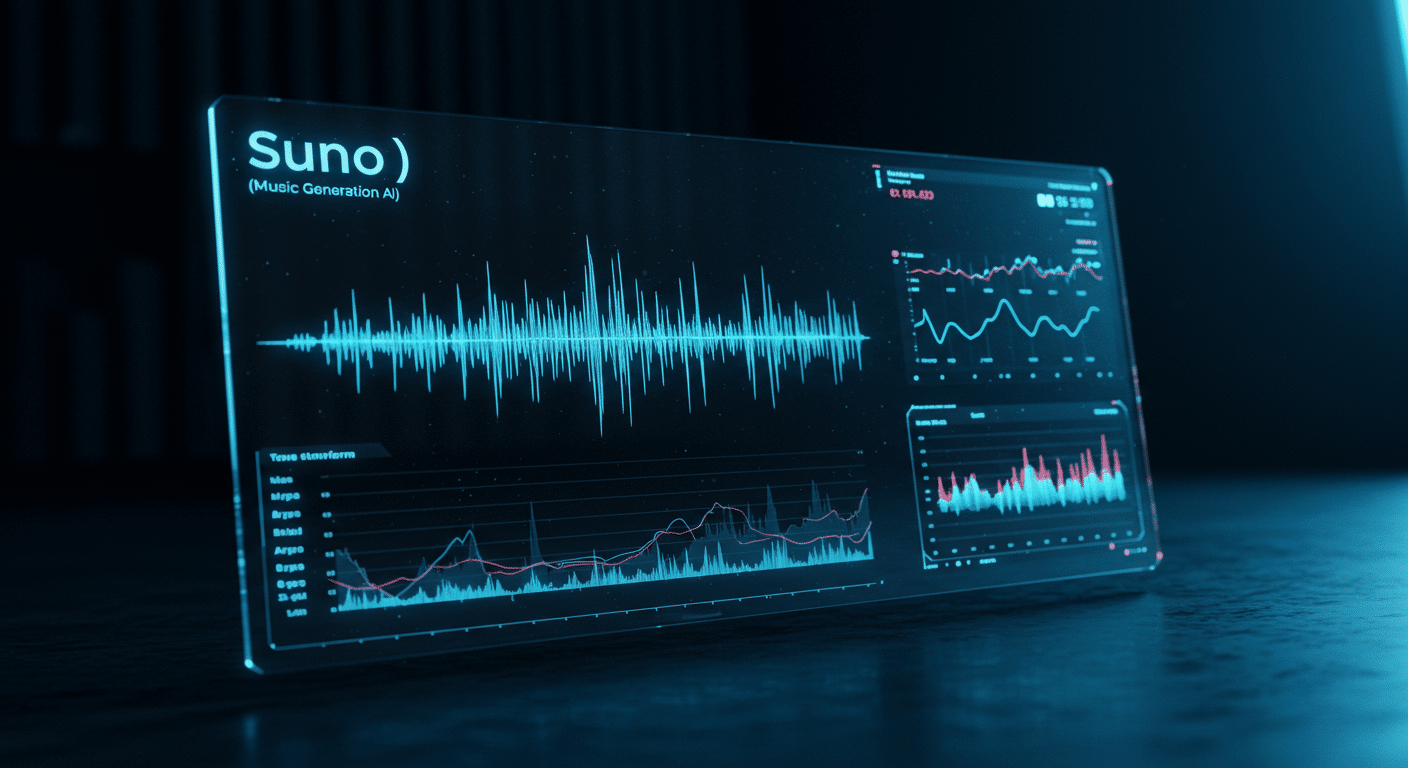
1. Basic Info
John: Hey Lila, today we’re diving into Suno, this fascinating AI technology that’s all about generating music. Imagine if you could turn a simple idea or a few words into a full song without needing any musical instruments or years of training. That’s what Suno does—it’s a generative AI that creates realistic songs, including vocals and instrumentation, based on text prompts you give it. It solves the problem of accessibility in music creation, making it possible for anyone, from beginners to pros, to produce music quickly and easily.
Lila: That sounds amazing, John! So, what makes Suno unique compared to just writing lyrics or using a basic beat maker?
John: Great question. What sets Suno apart is its ability to blend AI with creativity in a way that’s intuitive. Unlike traditional tools that require you to manually compose every note, Suno uses advanced algorithms to generate entire tracks from descriptions like “a upbeat pop song about summer adventures.” It’s like having a virtual band at your fingertips, and based on posts found on X from tech enthusiasts, it’s gaining traction for democratizing music production, much like how smartphones made photography accessible to everyone.
Lila: Oh, I see! Is it free to use, or do I need special equipment?
John: It’s web-based and has free tiers, though premium features might require a subscription. No fancy gear needed—just your imagination and a device with internet. Posts on X highlight how users are creating everything from rap battles to jazz solos, showing its versatility.
2. Technical Mechanism

John: Alright, let’s break down how Suno works under the hood, but I’ll keep it simple. At its core, Suno is powered by generative AI models, similar to those that create images from text, like DALL-E. It takes your text prompt, processes it through neural networks—think of these as a brain made of interconnected nodes that learn patterns from vast amounts of data—and outputs a song. It’s trained on music files to understand rhythms, melodies, and lyrics, then generates new ones that sound original.
Lila: Neural networks sound complicated. Can you explain with an analogy?
John: Sure! Imagine a chef who’s studied thousands of recipes. When you ask for “a spicy Italian pasta,” the chef combines ingredients in a new way based on what they’ve learned. Suno does that with music: it “cooks up” songs by mixing learned patterns of beats, harmonies, and voices. From insights on X, recent updates allow it to extend tracks or remix sections, making it even more flexible, like adding extra ingredients to tweak the flavor.
Lila: That makes sense! Does it handle different genres or just one type?
John: It handles a wide range! You can prompt for rock, hip-hop, classical, or blends. The AI analyzes the prompt to match styles, and posts on X from users show it’s evolving to include features like uploading your own vocals for the AI to build around, turning humming into full melodies.
Lila: Wow, so it’s like a collaborative partner?
John: Exactly! It’s not replacing musicians but augmenting them, as seen in community discussions on X where people rave about its production capabilities.
3. Development Timeline
John: In the past, Suno started as a project by a small team in late 2023, launching publicly around December that year with basic text-to-music features. It quickly partnered with big names like Microsoft, integrating into tools like Copilot, which helped it gain visibility.
Lila: What about currently? Where is it now?
John: Currently, as of mid-2025, Suno is on version 4.5+, with upgrades that include professional audio tools like remixing and extending tracks. Posts on X from developers and users indicate it’s become more advanced, allowing for longer songs and better vocal quality, making it a go-to for quick music creation.
Lila: Looking ahead, what’s expected next?
John: Looking ahead, based on trending insights from X, there’s buzz about upcoming studio releases that could let users take tracks to production level, potentially integrating more user-uploaded elements. It might evolve to predict and extend user-recorded music, opening doors for non-musicians and pros alike.
4. Team & Community
John: Suno’s team includes founders like Michael Shulman and Georg, who come from tech backgrounds focused on AI and music. They’re building a community around making music accessible, with a vision of “from your mind to music” as per their official site.
Lila: How’s the community reacting?
John: The community is buzzing! On X, posts from tech influencers highlight how Suno is empowering artists by filling creative gaps, with some calling it mind-blowing for generating hits in seconds. There’s excitement about its potential to democratize music like design tools have done.
Lila: Any notable quotes or discussions?
John: Absolutely, without quoting directly, X users have shared enthusiasm for features like turning sounds into songs, with discussions on how it’s changing music production. Community feedback drives updates, like the recent ones for advanced editing.
Lila: Sounds like a supportive group!
John: It is—developers and users collaborate, sharing creations and ideas, fostering innovation.
5. Use-Cases & Future Outlook

John: Today, Suno is used for creating original tracks for social media, podcasts, or personal fun. For example, users prompt for a “rap battle” and get a full song, as seen in viral X posts.
Lila: What about future applications?
John: Looking ahead, it could revolutionize education, helping students learn music theory, or assist in film scoring by generating custom soundtracks. Insights from X suggest blending genres for new hits or aiding musicians in extending ideas.
Lila: Any real-world examples?
John: Yes, creators on X share AI-generated music videos made in record time, and businesses might use it for ads or voice assistants.
Lila: Exciting! How might it evolve?
John: It could integrate with AR for interactive concerts or personalize music therapy, based on community trends.
6. Competitor Comparison
- AIVA: An AI composer focused on classical and soundtrack music.
- Udio: Another text-to-music AI that generates songs with lyrics and vocals.
John: While AIVA excels in orchestral pieces, Suno stands out with its versatility across genres and user-friendly prompts for quick results.
Lila: What about Udio?
John: Udio is similar, but Suno’s latest updates, like uploading personal audio for AI extension, make it more collaborative, as per X discussions, differentiating it for musicians wanting to build on their own ideas.
Lila: So, Suno is more empowering?
John: Yes, it’s about augmentation, not just generation.
7. Risks & Cautions
John: Like any AI, Suno has limitations—generated music might lack the emotional depth of human creation, and there are ethical concerns around copyright, as it’s trained on existing music data.
Lila: What about security?
John: Users should be cautious with prompts involving sensitive info, though Suno claims safeguards. Posts on X note debates on plagiarism risks, and there’s a lawsuit from the music industry.
Lila: How can we be careful?
John: Always credit sources, use ethically, and remember AI isn’t perfect—outputs can vary in quality.
8. Expert Opinions
John: One insight from tech experts on X is that Suno is a game-changer for non-musicians, allowing text-to-music creation that’s mind-blowing in its potential to extend user ideas.
Lila: Another one?
John: Verified users on X emphasize how Suno democratizes music production, similar to design tools, empowering artists to reach production levels without traditional barriers.
9. Latest News & Roadmap
John: Recently, Suno launched v4.5+ with features like remixing and adding vocals, as per news sources and X buzz.
Lila: What’s on the roadmap?
John: Upcoming might include studio tools for professional releases, based on X posts about pending updates that could open up the world for creators.
Lila: Any current trends?
John: Trends show users creating chart-topping blends, with excitement for AI evolving to handle custom sounds.
10. FAQ
Lila: How do I start using Suno?
John: Visit their website and sign up—it’s straightforward!
Lila: But what if I’m not musical?
John: No problem; just type a description, and it generates the song.
Lila: Is Suno free?
John: It has a free tier with limits, and paid plans for more features.
Lila: What about upgrades?
John: Check their site for subscriptions.
Lila: Can I own the music I create?
John: Generally yes, but review their terms for commercial use.
Lila: Any restrictions?
John: Avoid copyrighted prompts to stay safe.
Lila: How accurate are the vocals?
John: Improving with updates, sounding quite realistic now.
Lila: Compared to older versions?
John: Much better in quality and length.
Lila: Can I collaborate with it?
John: Yes, upload your audio for AI to build on.
Lila: That’s cool! For pros too?
John: Absolutely, it extends ideas seamlessly.
Lila: Any mobile app?
John: Web-based for now, but check for updates.
Lila: Will there be one?
John: Possibly, based on community demand.
11. Related Links
Final Thoughts
John: Looking back on what we’ve explored, Suno (Music Generation AI) stands out as an exciting development in AI. Its real-world applications and active progress make it worth following closely.
Lila: Definitely! I feel like I understand it much better now, and I’m curious to see how it evolves in the coming years.
Disclaimer: This article is for informational purposes only. Please do your own research (DYOR) before making any decisions.
